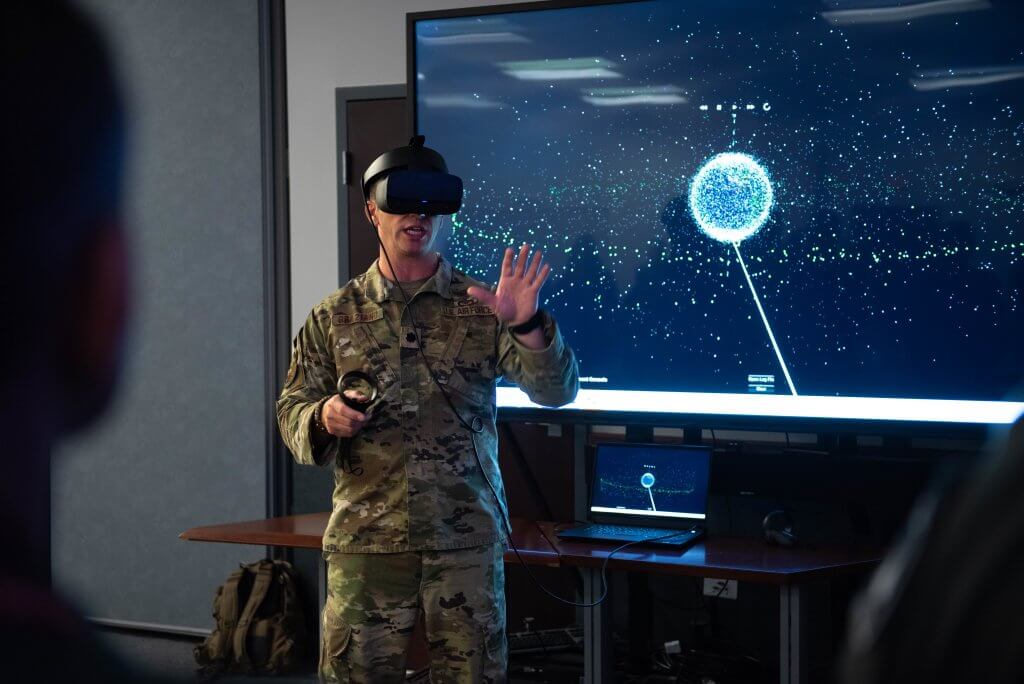The current space-operations setup is “orphaned” and unsustainable, residing in the Air National Guard, untethered to an active-duty component.
That’s according to the roughly 10 state military representatives from California, Colorado, Hawaii, New York and Ohio who spoke during a media briefing hosted by the Colorado National Guard on Friday.
The event was a partial response to White House Office of Management and the Budget (OMB) statements made late last year, which recommended against locating U.S. Space Force missions in the Reserve Component.
Uniformed service members variously described how Air National Guard units are currently tasked with space-based defense operations that support civil authorities, fulfill homeland security missions and maintain go-to-war mobilization capabilities.
“The Air National Guard has been conducting these missions, despite the fact that we’ve been orphaned since the creation of the Space Force in 2019,” said Col. Tim Stanley, commander of the New York Air National Guard’s 222nd Command and Control Squadron (CACS).
According to briefers, some 13 Air National Guard units in eight states and territories currently fulfill space-related missions.
In Colorado, for example, Air National Guard Capt. Kathryn Nay, of Task Force FireGuard, helps head-up a joint team comprising Colorado and California military intelligence analysts. The 24/7 effort supports civil agencies in monitoring wildfire conditions.
“We serve as another tool in the toolkit for our interagency partners,” she said.
In Ohio, Air National Guard Chief Master Sgt. Tyler Kempf described how 25% of the state’s 56-member 126th Intelligence Squadron currently on active-duty is deployed using Space Force funding.
“We like to consider ourselves something of a proof-of-concept,” he said.
In Hawaii, Air National Guard Lt. Col. Christopher Briggs, of the 293th Space Control Squadron, noted that the Reserve Component is responsible for 50% of the military’s communications satellite command-and-control capability, 30% of strategic missile-warning capability, and 60% of the Total Force’s offensive space-electromagnetic warfare capacity.
RELATED: Lack of Space National Guard would lead to ‘increased bureaucracy,’ colonel says
“The warfight is our primary mission in the National Guard, and the heart of everything,” he said.
In preparation for the next fiscal year, congressional leaders and lobbyists are pushing for the creation of a Space National Guard based on the existing Air National Guard space-missions footprint.
Proponents argue the move would save money, and avoid losing decades of trained-and-ready experience in the Air Guard.
That runs counter to some of last year’s budget discussions.
“Establishing a Space National Guard would not deliver new capabilities — it would instead create new government bureaucracy, which the Congressional Budget Office estimates could increase costs by up to $500 million annually,” reads a September 2021 statement of Biden administration policy, referencing the National Defense Authorization Act (NDAA) for the current 2022 fiscal year.
In introducing a May 2022 bipartisan bill to establish a Space Guard, Sen. Diane Fienstein (D-Calif.) remarked that Senate File 4179 “would shift our National Guard units performing space missions from the Air National Guard, which is part of the Air Force, to a Space National Guard, which would fall under the Space Force. This bill does not authorize new construction, bases, or personnel. It is a realignment, not an expansion.”
The National Guard Association of the United States (NGAUS) also has voiced support for the creation of a Space Guard.
“The OMB incorrectly presumed that every state would stand up Space National Guard units, which greatly inflated its cost-projections,” NGAUS President J. Roy Robinson, a retired Army brigadier general, stated in a June 7 letter to President Joe Biden. “It also ignored Air Force studies concluding the most efficient reserve-component solution for the Space Force is a Space National Guard … The start-up cost, according to the Pentagon, would be approximately $250,000 — the price to change signs and uniform name tapes.”
At Friday’s online media event, the New York Air National Guard’s Col. Stanley echoed some of that analysis. The earlier Congressional Budget Office estimates, he said, included assumptions such as 100-person space operations staff at National Guard Bureau (he estimated 30 personnel currently perform those duties), construction of a new Space Guard headquarters building and an organizational footprint across 20 states.
“There would be no-growth and no-costs in a zero-balance transfer of units and current funding from the Air National Guard to a Space National Guard,” Stanley said.
The senate bill would affect a total of approximately 1,000 Air Guard personnel in the following units:
- Alaska: 213th Space Warning Squadron
- California: 148th Space Operations Squadron; 216th Space Control Squadron; 234th Intelligence Squadron
- Colorado: 233rd Space Group; 137th Space Warning Squadron; 138th Space Control Squadron; 233rd Space Communications Squadron
- Florida: 114th Space Control Squadron
- Guam: 254th Space Control Squadron
- Hawaii: 293rd Space Control Squadron
- New York: 22nd Command and Control Squadron
- Ohio: 126th Intelligence Squadron
The bill has been referred to the Senate Armed Forces Committee. In addition to Sens. Diane Feinstein (D-Calif.) and Marco Rubio (R-Fla.), original co-sponsors of the effort included:
- Marsha Blackburn (R-Tenn.)
- Mike Braun (R-Ind.)
- John Cornyn (R-Texas)
- John W. Hickenlooper (D-Colo.)
- Lisa Murkowski (R-Alaska)
- Joe Manchin (D-W.V.)
- Alex Padilla (D-Calif.)
- Rob Portman (R-Ohio)
- Rick Scott (R-Fla.)
On June 13, Sen. Jacky Rosen (D-Nev.) joined as a co-sponsor.

